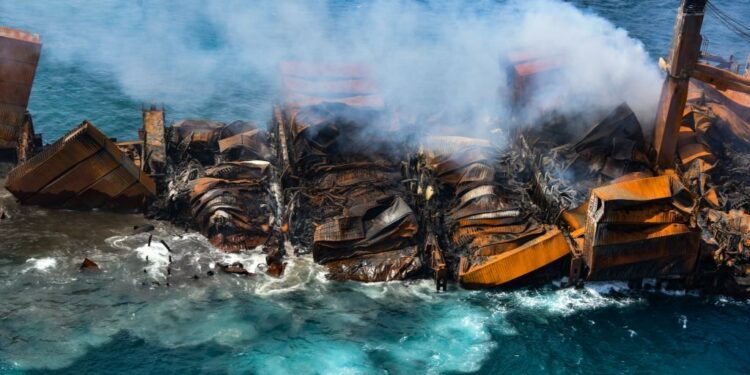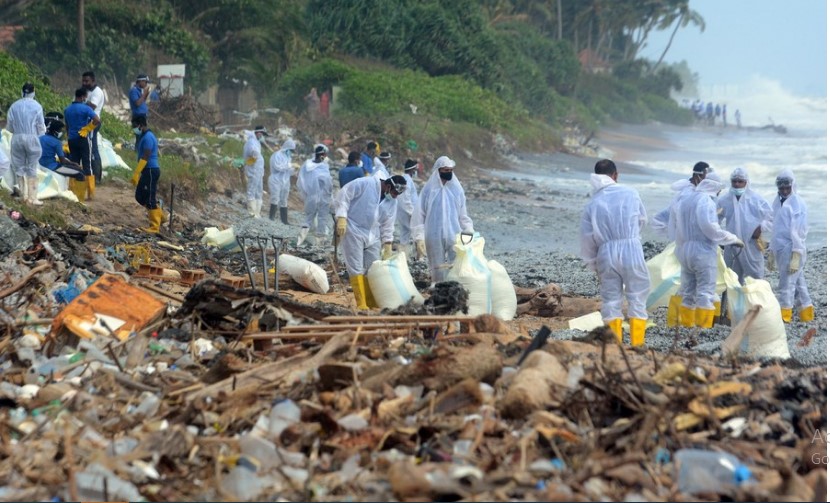MV X-Press Pearl could have been saved if the acid leak was fixed before it sailed to Colombo
Posted on June 6th, 2021
By Sarasi Wijeratne/Counterpoint.lk Courtesy NewsIn.Asia

Colombo, May 28: The ill-fated container vessel X-Press Pear, which burned and sank off Colombo, could have been saved if the Nitric acid leak had been fixed before it sailed to Colombo.
The ship’s crew had detected the leak after it left Jebel Ali in Dubai where it had loaded cargo and was enroute to Hamad in Qatar. The leak was allegedly not fixed here and nor was it fixed in Hazari in India which was its next stop. The ship, which was on a fixed port rotation between these ports was a regular and the next port of call was Colombo.
‘In addition to responsibilities under the fixed port rotation system we have a Port of Refuge and support services obligation and we could not have turned the ship away,’ said a high–level source at the Sri Lanka Ports Authority(SLPA). ‘It could have resulted in a criminal prosecution’.
Denying the ship had not been allowed entry to Hamad and Hazari the source clarified that it was allowed entry into these ports to offload and reload cargo but the leak allegedly was not fixed. According to the source the prevailing ground conditions were instrumental. ‘The ship was in Hamad during the Ramadan season and in Hazari it could not get help because of Covid’.
Ports provide a rework and discharge facility that ships can make use of to repair a leak or replace the container. It is a service all countries are obliged to provide under international maritime regulations. ‘In this case, it could have taken about four hours for the leak to be fixed, depending on the cargo which had to be offloaded and reloaded for the corrective work to be done’.
Just before midnight on the 20th of May a fire broke out on the deck of the MV X -Press Pearlwhich was located 9.5 nautical miles from the Colombo port where it had dropped anchor early that morning. It is also 4.5 nautical miles or 8.5 kilometers from the Negombo coastline and 15 km from the mouth of the Kelani river and the Colombo Port City.
At the time the fire broke out the ship, which had been released from a yard in China in February and was registered in Singapore, was carrying 1486 containers of dangerous and general cargo. The 81 containers which had dangerous cargo included 25 tonnes of nitric acid and caustic soda, methanol and other chemicals. The nitric acid was stored in 36 international bulk containers on the outside deck and the leak is believed to have originated in these containers because of poor quality packaging, one of the top reasons for fires on board ships. Among the general items were consumer products and cosmetics. About 22 containers of a transshipment with cosmetics, aluminum melting products and environment hazard containers were to be offloaded in Colombo.
Before it enters the port a ship is routinely required to provide a detailed breakdown of the cargo it is carrying including the number of containers and the insurance cover that it has. ‘This information has to be provided 48 hours before the ship enters the port’, said the source who confirmed that details of MV X-Press Pearl’s cargo including items classified as dangerous had been furnished. The SLPA however was not informed about the leak which was declared to them only after the ship had anchored.
At 10.19 am on 20th May the ship’s local agent Sea Consortium Lanka sent the SLPA a mail informing it about the leak. When a team from the SLPA which included its deputy fire chief boarded the ship for an inspection after they detected smoke in cargo room 2 in the hold. The location had been sprayed with carbondioxide with the consent of the vessel’s master. The fire which eventually raged through the ship had reportedly started on the top deck.
‘It is still unclear what happened especially since the fire started where the deck cargo was and not where the smoke was detected’. It could have been a combination of factors such as the poor packaging which caused the nitric acid to leak and mix with water and the caustic soda which was stored immediately below in the hold’.
The Meteorology department had issued a weather warning for those days and the ship was in an area where the weather was bad and the sea was rough, hampering the work of the tugs that were fighting the flames which had erupted on board. A lightning strike sparking the flames is also emerging as a possibility. According to eyewitnesses the clouds of smoke which were billowing from the ship were red, an indication that the nitric acid was burning.
Meanwhile the 25– member crew who had remained on board until then were evacuated from the ship and are currently in quarantine. Two crew members who were injured during the evacuation had to be hospitalized for treatment.
In the weeks to come while international investigators start looking to establish how the ship met with its fate the priorities for disaster responders now will be to contain the spread of the fire and minimize environmental damage.
The Navy spokesman Captain Indika Silva said they had spoken with the Indian coastguard which had sent two vessels to deal with eventualities leading to environmental pollution. He said the owners of the vessel have assigned a salvage company to deal with the fire and two tugs have been hired to fight the fire which is still raging and putting at risk the ship’s structural stability.

The Navy has also deployed its men along the western coastline from Dikowita to Chilaw and Wellawatte to Panadura to recover cargo that was washed ashore after eight containers from the ship fell in the sea. Local people were seen carrying the cargo away despite warnings from environment agencies to stay away from goods and debris because they can be toxic. Fishermen have been told to refrain from fishing in the area in the coming days. The Central Environment Authority and Urban Development Authority were expected to visit the location today to assess the situation.
Professor of Coastal Oceanography at the University of Western Australia Charitha Pattiaratchi said the ship will either burn up or sink. ‘You just have to sit it out and prepare for what could happen next. But the chemicals will not be persistent because unlike oil in the ocean chemicals get diluted and neutralised’. While danger to marine life will range from the short to long– term depending on the species and its peculiarities, the bigger concern is the potential of an oil spill.
Based on computer modelling done by him if there is an oil spill from the ship it could spread to the coast between Colombo and Negombo transported by the combination of wind and currents. ‘It is likely that it will head more to the southwest. Oil that reaches the coastline will stay there for a while and it will persist’. His projections anticipate the spill to extend about 10 km along the coastline. ‘In terms of preparation, it should be on gearing up to clean the beach and also to rescue animals and birds such as seagulls who will come to the beach’.
This latest maritime disaster comes not so long after the fire on the MT New Diamond in September last year. The ship was transporting around two million barrels of crude oil when a fire broke out in the engine room when it was 65 kilometers off Sangaman Kanda Point along the east coast of Sri Lanka. After burning intermittently for almost a week, the fire was finally extinguished but not before the waters around it were spiked with a diesel oil spill of about 1 km long.
Pattiaratchi who works closely with Sri Lanka during maritime disasters points out that in the case of the New Diamond which was a crude oil carrier the wind and waves took it further away from the coast. In the current case the ship is close to the coast and the southwest monsoon is also strong which enhances the risk of environmental damage on shore.

A major disaster was averted with MT New Diamond because of a combination of favourable atmospheric and ocean conditions and the effective management of the fire on board. But we may be not be so lucky the next time and an incident can cause significant environmental, ecological, financial, social effects to coastal populations’. The is highlighted in the current incident where the weather conditions were challenging, the ship was closer to the coast and the winds and currents were such that debris and oil are being transported to the shore.
He underscores the importance of disaster preparedness with direct action and long-term planning to mitigate the impact of disasters such as tsunamis, extreme weather events and oil spills that pose significant environmental, ecological, financial, social and legal risks to coastal populations globally.
‘We have to develop and put in place structures that can respond to such disasters by not being reactive but being proactive’, points out Pattiaratchi.
One challenge is to centralize information to ensure the availability of complete data sets. Although information that is required to develop mitigation strategies during these events are available they are distributed across many agencies. For example, high-resolution topography data from the ocean and land are not readily available for input into computer models that predict locations where oil may come ashore and this data is fundamental to predict coastal disasters.
Lack of preparedness including scientific and technological expertise, particularly in handling a crisis such as an oil spill is not a challenge that Sri Lanka faces alone it is an issue for many other smaller, developing nations of the Indian Ocean rim as well. These obstacles only make a stronger case for significant improvements in transboundary cooperation. Regional bodies such as the Indian Ocean Rim Association (IORA) should take on a more proactive role in addressing and responding to challenges that small and littoral states find tough to meet individually.